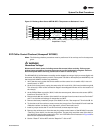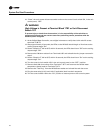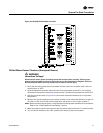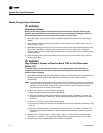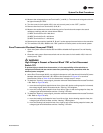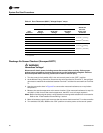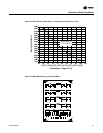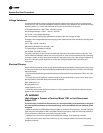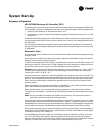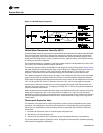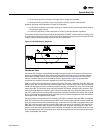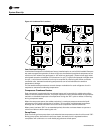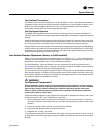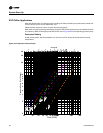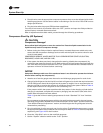
SS-SVX09A-EN 83
System Start-Up
Sequence of Operation
VAV W7100A Discharge Air Controller (7U11)
The discharge air controller used in Variable Air Volume applications is a Honeywell W7100A. This
microprocessor controller is designed to maintain an average discharge air (D/A) temperature by:
1. monitoring the discharge air temperature sensor; and
2. modulating economizer dampers and sequencing stages of mechanical cooling “On” or “Off”,
as required.
The W7100A receives analog input from the discharge air sensor mounted in the supply duct every
2 to 3 seconds by pulsing DC current across the sensor, then “reading” the voltage potential across
this thermistor.
If the comparison between the setpoint and the actual discharge air temperature indicates that
cooling is required, the W7100A attempts to satisfy the load by modulating the economizer open
(if applicable).
Economizer Cycle
The economizer is only allowed to function if the ambient conditions are below the setpoint of the
enthalpy switch.
If the ambient air conditions are above the enthalpy setpoint, the W7100A will open the Fresh Air
dampers to the minimum setpoint position.
To take full advantage of the “free cooling” provided by the economizer, the W7100A “resets” the
discharge air setpoint. The amount of “reset” between the actual discharge air setpoint and the
economizer control point is equal to 1/2 of the W7100’s control band setpoint.
Example: With a typical control band setting of 6oF, the amount of discharge air “reset” is 3ºF (1/
2 of the control band setpoint). Therefore, if the discharge air setpoint is 55ºF, the economizer
control point is 52ºF (i.e., 55ºF - 3ºF).
A second economizer “algorithm” within the W7100A is the response time of the controller. The
greater the amount of deviation between the discharge air temperature and the economizer control
point, i.e., as the temperature strays further from the control point, the response time becomes
faster; and, as the discharge air temperature approaches the control point, the response time
becomes slower.
When the discharge air temperature is within the “Deadband” (± 1.5ºF of the economizer control
point); the W7100A maintains the economizer’s present position.
When the economizer can not handle the cooling requirement or when the outdoor ambient
conditions are unsuitable for “economizing”, the W7100A activates the unit’s mechanical cooling
section.
Note: As long as ambient conditions are suitable for economizing, the economizer works in
conjunction with the mechanical cooling operation.
The control algorithm used by the W7100A to add stages of cooling is illustrated in Figure 41. When
the discharge air temperature drifts above the setpoint, “Region 1”, a stage of mechanical cooling
is added based on time and the amount of deviation from setpoint. If the discharge air temperature
remains above the setpoint, the W7100A energizes additional stages of mechanical cooling.
If the operating cooling stage is capable of satisfying the cooling requirement, as the discharge air
temperature falls below the setpoint for a sufficient period of time, the W7100A turns the stages
of mechanical cooling “Off”, “Region 3”.
The W7100A determines the length of the time before stages of mechanical cooling are turned
“On” and “Off”. When the system is operating within the control band, the delay is longest at
setpoint, and decreases to a minimum of 4 minutes when the discharge air temperature exceeds
the upper or lower limit of the control band. Refer to the illustration in Figure 41.



